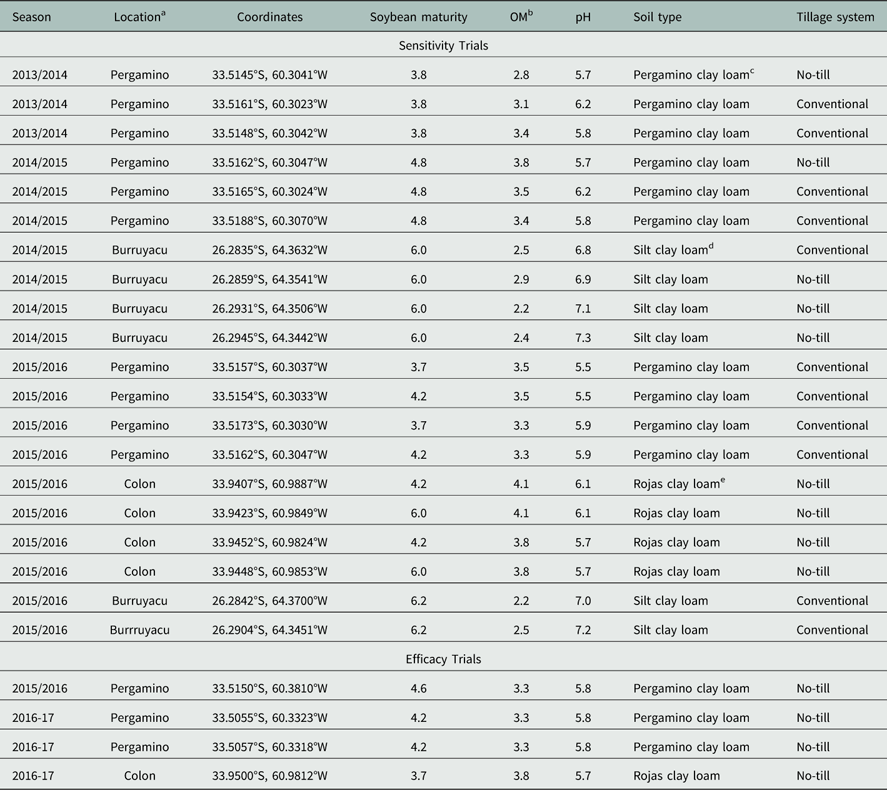Soybean production in Argentina has increased from 6.6 to more than 20 million hectares from 1995 to 2016 (Bolsa de Comercio de Rosario 2016). In Argentina, approximately 90% of soybean is produced in no-till cropping systems (AAPRESID 2012). Glyphosate-resistant (GR) soybean varieties were first introduced in 1996, and within 4 years 90% of acres were planted with GR soybean (Penna and Lema Reference Penna and Lema2003) because this new technology provided Argentine farmers improved and simplified weed control that cost less than prior weed management programs (Binimelis et al. Reference Binimelis, Pengue and Monterroso2009). During the early years of GR soybean, glyphosate was widely applied before planting to control emerged large crabgrass [Digitaria sanguinalis (L.) Scop], Echinochloa species, spurred anoda [Anoda cristata (L.) Schltdl.], Amaranthus species, wild marigold (Tagetes minuta L.), and large thornapple (Datura ferox L.). Following planting, one or two POST glyphosate applications were commonly used to control common lambsquarters (Chenopodium album L.), spurred anoda, Amaranthus species, wild marigold, and both annual and perennial grasses in crop.
The first case of GR johnsongrass [Sorghum halepense (L) Pers.] was confirmed in 2005, and with each passing cropping season glyphosate resistance continues to increase (Vila-Aiub Reference Vila-Aiub, Balbi, Gundel, Ghersa and Powles2007). Glyphosate-resistant biotypes of Sumatran fleabane, smooth pigweed (Amaranthus hybridus L.), Palmer amaranth (Amaranthus palmeri S. Watson), Gramilla mansa (Cynodon hirsutus), sourgrass [Digitaria insularis (L.) Mez ex Ekman], junglerice [Echinochloa colona (L.) Link], goosegrass [Eleusine indica (L.) Gaertn.], Italian ryegrass (Lolium multiflorum Lam.), and johnsongrass have since been confirmed (AAPRESID 2017; Heap Reference Heap2017). Additionally, glyphosate-tolerant Borreria spp., Gomphrena spp., and feather fingergrass (Chloris virgata Sw.) are emerging as weeds of concern in Argentinean soybean production (Palau et al. Reference Palau, Senesi, Mogni and Ordoñez2015). Glyphosate-resistant weeds are a major limitation to soybean, corn (Zea mays L.), sunflower (Helianthus annuus L.), winter wheat (Triticum aestivum L.), and winter barley (Hordeum vulgare L.) production systems (Vila-Aiub Reference Vila-Aiub, Vidal, Balbi, Gundel, Trucco and Ghersa2008).
In South America, Conyza species germinate and emerge during the winter fallow period (June to September). In the no-till production system, a preplant herbicide application is required to control the Conyza species prior to planting. Prior to the development of GR crops, glyphosate was exclusively used to control weeds, including Conyza species, prior to soybean planting. Conyza species can be highly competitive, with failure to control resulting in soybean yield reduction of over 80% (Byker et al. Reference Byker, Soltani, Robinson, Tardif, Lawton and Sikkema2013). To control GR Conyza species prior to planting, glyphosate has been mixed with synthetic auxins (2,4-D or dicamba), acetolactate synthase inhibitors (diclosulam or chlorimuron), or protoporphyrinogen oxidase inhibitors (saflufenacil) (Metzler Reference Metzler, Puricelli and Papa2014). Short residual activity of the added herbicide can require soybean planting to be delayed following the preplant application. In the United States, depending on rate applied, a 14- to 30-day interval between applications of 2,4-D dimethylamine or dicamba and soybean planting is required (Loux et al Reference Loux, Doohan, Dobbels, Johnson, Young, Legleiter and Hager2017; Thompson et al. Reference Thompson, Steckel, Ellis and Mueller2007). Similarly, Bedmar (Reference Bedmar and Lagarde2003) observed in Argentina that 15 and 30 days was required between 2,4-D application and soybean planting to avoid injury to soybean. Development of Sumatran fleabane populations in Argentina with resistance to EPSPS and acetolactate synthase–inhibiting herbicides further limits control options (Santos Reference Santos, Oliveira, Constantin, Fransischini and Osipe2014).
Enlist E3TM soybean (DAS-44406-6) contains three genes: 1) aryloxyalkanoate dioxygenase-12 (aad-12); 2) double mutant 5-enolpyruvylshikimate-3-phosphate synthase (2mEPSPS); and 3) phosphinothricin acetyltransferase (pat), which convey resistance to 2,4-D, glyphosate, and glufosinate, respectively (Wright et al. Reference Wright, Shan, Walsh, Lira, Cui, Song, Zhuan, Arnold, Lyn, Yau, Russel, Cicchillo, Peterson, Simpson, Zhou, Pansamuel and Zhang2010). Enlist E3 soybean was deregulated in Argentina in 2015. Enlist E3 soybean plants are able to tolerate 2× rates glyphosate, 2,4-D choline or glufosinate when applied PRE or POST from emergence to R2 growth stages of soybean (Peterson et al. Reference Peterson, Shan, Walsh and Wright2011; Robinson et al. Reference Robinson, Simpson and Johnson2015; Wright et al. Reference Wright, Shan, Walsh, Lira, Cui, Song, Zhuan, Arnold, Lyn, Yau, Russel, Cicchillo, Peterson, Simpson, Zhou, Pansamuel and Zhang2010).
Enlist™ herbicide with Colex-D™ technology is a 2,4-D choline salt (456 g ae L−1) formulation developed by Dow AgroSciences, LLC for use in Enlist crops [corn, soybean, and cotton (Gossypium hirsutum L.) in Argentina, Brazil, the United States, and Canada] (Li et al. Reference Li, Tank, Liu, Qin, Wilson and Ouse2010, Reference Li, Tank, Kennedy, Zhang, Downer, Ouse and Liu2013). The Colex-D technology provides significant reduction in drift, odor, and volatility plus improved compatibility between 2,4-D and glyphosate (Li et al. Reference Li, Tank, Liu, Qin, Wilson and Ouse2010, Reference Li, Tank, Kennedy, Zhang, Downer, Ouse and Liu2013). When combined with the appropriate drift-reduction nozzles, Enlist herbicide plus glyphosate can reduce the amount of driftable fines by 90% versus a mixture of 2,4-D and glyphosate (Hillger et al. Reference Hillger, Qin, Simpson and Havens2012). The Enlist herbicide registered rates in Argentina range from 720 to 1,140 g ha−1 of 2,4-D choline to be applied on Enlist E3 soybean from preemergence through the R2 crop stage. Programs of residual herbicide applied PRE followed by POST applications of Enlist herbicide plus glyphosate provide consistent control of GR Palmer amaranth, tall waterhemp (Amaranthus rudis J. D. Sauer), and giant ragweed (Ambrosia trifida L.) (Ellis et al. Reference Ellis, Ruen, Moechnig, Scherder, Rosenbaum, Campbell, Haile and Granke2014; Ruen et al. 2014; Simpson et al. Reference Simpson, Rosenbaum, Ellis, Richburg, Haile, Granke, Thompson, Haygood and Walton2014). Enlist E3 soybean will provide flexibility to use glyphosate plus 2,4-D choline with and without residual herbicides 0 to 10 days before planting followed by an in-crop application of 2,4-D choline plus glyphosate or glufosinate. There are no currently published data on resistance of Enlist E3 soybean to 2,4-D plus glyphosate or glufosinate in Argentinean soybean crop production systems. The objectives of this research were 1) to determine the effect of Enlist herbicide applied with glyphosate on Enlist E3TM soybean sensitivity and yield and 2) to determine the response of GR Sumatran fleabane to Enlist herbicide applied in sequence and in combinations with selected PRE and POST herbicides.
Materials and Methods
Crop Sensitivity
Twenty Enlist E3™ soybean sensitivity trials were conducted in Argentina from 2013 through 2016 (Table 1). Fourteen of the trials were conducted in the Humid Pampa Region near Pergamino, Buenos Aires and Colon, Buenos Aires, a temperate area (35° south latitude), and six trials were conducted near Burruyacu, Tucumán in a subtropical area (29° south latitude). Seven varieties of Enlist E3 soybean that ranged from maturity groups 3.7 to 6.2 were tested (Table 1). Plot size was 3 m wide by 6 m long with each plot containing 6 rows with a 0.5-m spacing. Seeding rate was 320,000 seeds ha−1 with a planting depth of 3 to 4 cm. Experiments were designed as randomized complete blocks with four replications. Each treated replication was adjacent to a nontreated plot to enable more accurate assessment of treatment effects. Glyphosate at 1,200 g ha−1 was applied across the entire trial area for weed control before planting. Trial locations were selected for good drainage, uniform soil type, and low populations of weeds sensitive to glyphosate. Weeds in all plots were removed by hand at each location starting when soybean were at the one-leaf growth stage and continued periodically until crop harvest.
Table 1 Descriptions of Enlist E3™ soybean crop sensitivity and efficacy trials from 2013 to 2016 in Argentina.
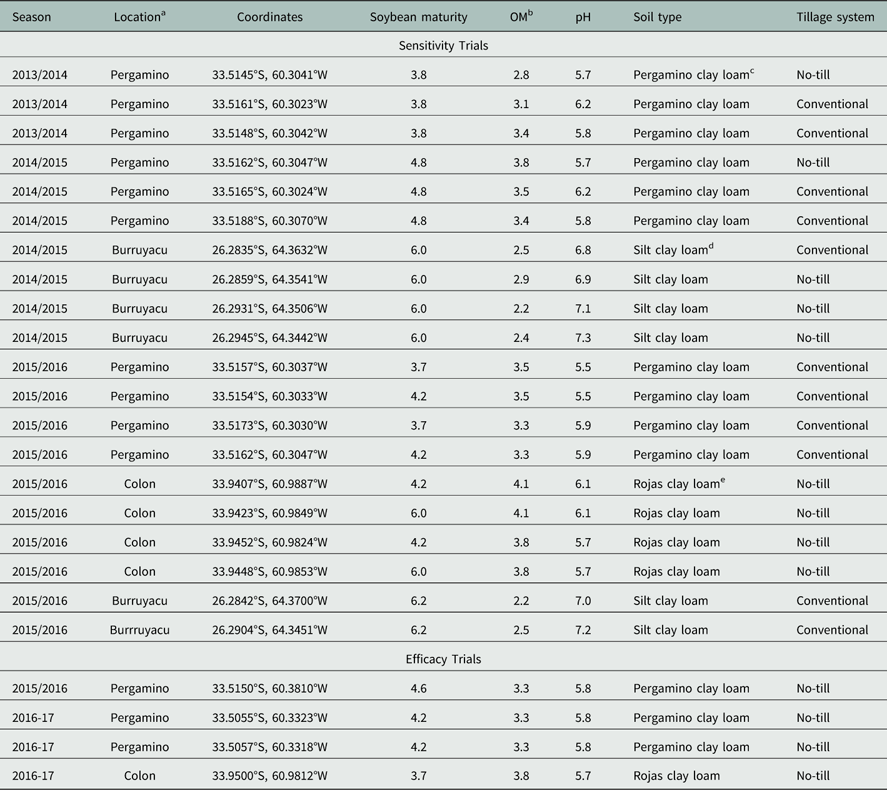
a Temperate environment at Pergamino and Colon trials sites and subtropical enviroment at Burruyacu.
b Abbreviation: OM, organic matter.
c Fine-loamy, illitic, thermic, Typic Argiudoll.
d Loam-sandy, loessic, Typic Haplustoll.
e Fine-loamy, mixed, thermic, Typic Argiudoll.
Herbicide treatments were applied with a CO2-pressurized backpack sprayer delivering a spray volume of 120 L ha−1 at 275 kPa through a 2.5-m spray boom with six AIXR110015 flat-fan nozzle tips spaced 50 cm apart. Treatments containing 2,4-D choline plus glyphosate were applied at the maximum recommended rate of 1,140+1,140 gha−1 (1×) and at 2,280+2,280 gha−1 (2×) with 0.5% (v/v) of a methylated seed oil (MSO) adjuvant. In the 2014/2015 and 2015/2016 cropping seasons, glufosinate-ammonium at 600 g ha−1 plus ammonium sulfate at 2% (v/v) and glufosinate at 600 g ha−1 plus ammonium sulfate at 2% (v/v) plus 2,4-D choline at 1,140 g ha−1 were added to the treatments applied. Herbicide treatments were either applied as single application at V3 growth stage or sequential applications at V3 and V5 growth stages. Herbicide product information for these studies is presented in Table 2.
Table 2 Herbicide and adjuvant product application rates and manufacturer information used in Enlist E3™ soybean tolerance and Sumatran fleabane efficacy trials.
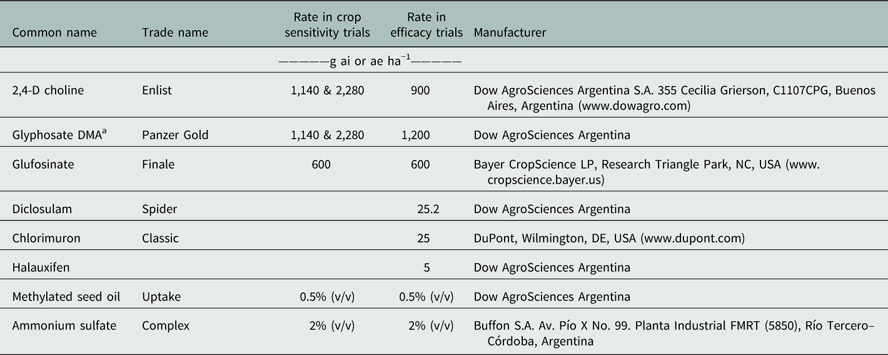
a Abbreviation: DMA, dimethylamine.
Crop sensitivity evaluations included percent (0% to 100%) injury that integrated a visual assessment of crop stand and height reduction, chlorosis, and necrosis. Visual estimates of injury were taken on a 0% to 100% scale averaged across all plants in the plot with visual injury ranging from 0% (no injury) to 100% (complete plant death). Crop sensitivity evaluations for single applications at V3 were made at 3, 14, and 21 days after application (DAA). Sequential applications were evaluated 3 and 14 DAA the V5 treatment. Soybean yield was determined by harvesting the four center rows in each plot with a small plot combine. Grain yields were adjusted to a 13.5% moisture content. For analysis, the grain yield from each herbicide-treated plot was converted to a percentage of that of the paired nontreated plot located immediately behind and adjacent to the herbicide-treated plot.
Efficacy
Four trials were conducted from 2015 through 2017 near Pergamino and Colon, Argentina,to determine the efficacy of various herbicide control programs on GR Sumatran fleabane in Enlist E3™ soybean. All trials were conducted in no-till soybean cropping systems. Enlist soybean varieties ranged from maturity group 3.7 to 4.6. Sumatran fleabane was 10 to 25 cm in height at application with density ranging from 120 to 190 plants m−2. Treatments were applied with a CO2-pressurized backpack sprayer that delivered a spray volume of 120 L ha−1 ha at 275 kPa with a 2.5 m boom with six AXR110015 flat-fan nozzle tips spaced 50 cm apart. Plot size was 5 m wide by 8 m long and contained nine rows with a 50-cm spacing between rows. The treated area in each plot was 3 m wide (six rows) by 8 m long with a lateral check (non-treated area) 2 m wide (3 rows) by 8 m long with 4 replications. Seeding rate was 320,000 seeds ha−1 with a planting depth of 3 to 4 cm. Applications were made 3 to 5 days before planting [preplant, 80% seedling emergence (at cracking), V4 to V5 crop stage (POST), and at V6 crop stage (LPOST)]. The herbicide treatments used in the different weed management programs are presented in Table 3. Sumatran fleabane control was evaluated at 6 weeks after PRE and 2 weeks after the LPOST applications. Evaluations were based on a scale of 0% to 100%, with 0% being no control and 100% indicating complete control. Soybean grain yield was determined by threshing all plants in the center four rows of each plot manually. Seed were collected and weighed and grain moisture was recorded. Yields were corrected to 13.5% moisture.
Table 3 Evaluation of herbicide programs in Enlist E3™ soybean for control of glyphosate-resistant Sumatran fleabane in Argentina in trials conducted in cropping seasons from 2015 through 2017.
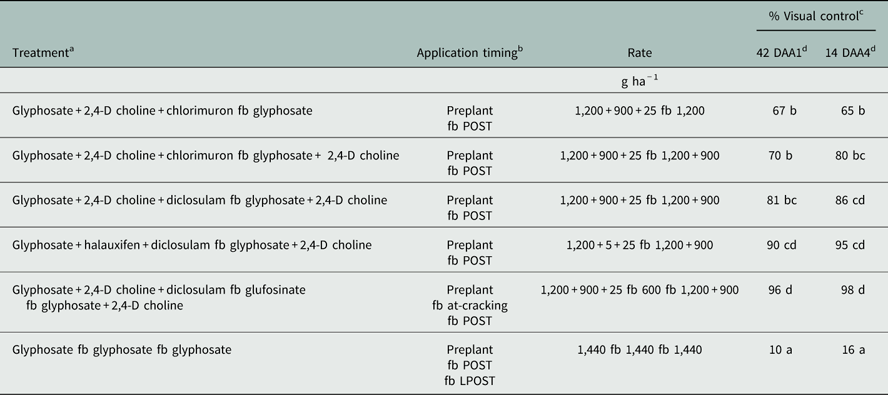
a Glufosinate treatments included ammonium sulfate at 2% (v/v).
b Abbreviations: Preplant, 5 to 3 days before planting; at-cracking, 10 days after preplant; POST, 42 days after planting; LPOST, 14 days after POST application; fb, followed by.
c Means within a column with no common letter(s) are significantly different according to Tukey’s HSD at P≤0.05.
d 42 DAA1, visual control rating taken 42 days after preplant application; 14DAA4, visual control rating taken 14 days after LPOST application.
Statistical Analysis
ANOVA assumptions, visual crop injury estimates, and yields were subjected to a Box-Cox transformation (Box and Cox Reference Box and Cox1964) using the car package in R, which determined the power transformation that maximized the log likelihood function for each response variable. However, back-transformed data is presented with means rounded to whole numbers and means separations based on transformed data. Where the ANOVA test indicated that treatment effects were significant, means were separated at α=0.05 using Tukey’s honest significant difference test. The crop sensitivity trials were pooled by temperate (Humid Pampa) and subtropical region in northwestern Argentina and analyzed separately. In efficacy trials, relative yield effects of different weed management program treatments were compared to the current commercial standard of glyphosate plus 2,4-D plus chlorimuron followed by glyphosate. Relative yields among treatments of all efficacy trials combined were compared using a mixed linear model with fixed effects (treatment, trial, treatment×trial) and random effects (trial×reps), where values are the mean yield impact.
Results and Discussion
Crop Sensitivity
Enlist E3™ soybean injury was low following POST applications of 2,4-D choline plus glyphosate DMA at 1×(1,140+1,140 g ha−1) and 2× (2,280+2,280 g ha−1) rates. The greatest injury was observed 3 days after 2,4-D choline plus glyphosate DMA application at V3. In the Humid Pampa, visual soybean injury at 3 DAA was 4% and 13 % at 1× and 2× rates, respectively, and in northwestern Argentina injury was 11% and 23 % at 1× and 2× rates, respectively (Tables 4 and 5). Greater injury in northwestern Argentina than in Humid Pampa may be attributable to differences in environmental conditions. The northwestern Argentina region had higher annual temperatures and lower thermal amplitude during the year than did Humid Pampa. Analysis of the interaction of soybean variety and region was not possible because the varieties were of different maturities and were not evaluated in both regions. In both regions, injury was only on leaves present at time of application and new leaves that emerged after application showed no crop injury. By 14 and 21 days after application, injury declined to less than 5%. Crop injury was expressed as necrotic leaf spotting for treatments containing 2,4-D choline and leaf chlorosis when glufosinate was applied alone (Figures 1 and 2). At 14 days after V3 applications, injury caused by the 1× rate declined to 2% or less and injury caused by the 2× rate ranged from 7% and 10%. Necrosis caused by 2,4-D choline and chlorosis produced by glufosinate were detected on leaves that intercepted the spray solution at the time of application. Leaves emerging after application showed no signs of necrosis or chlorosis (Figures 1 and 2).
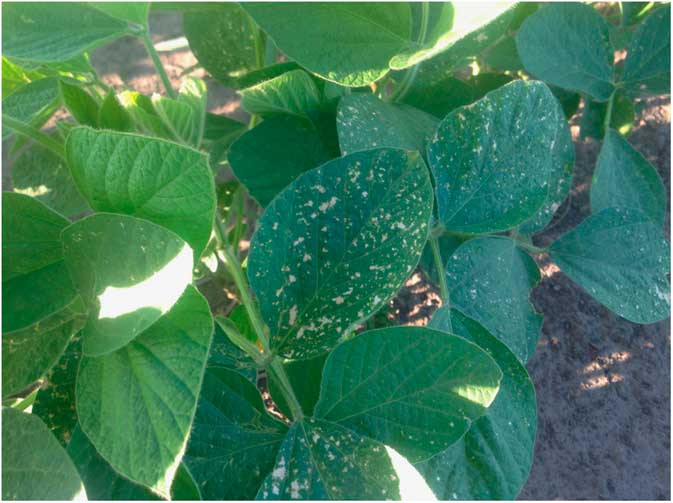
Figure 1 Necrotic Enlist E3™ soybean leaves 5 days after application of 2,4-D choline plus glyphosate DMA at 1,140+1,140 g ha−1 (1× rate).
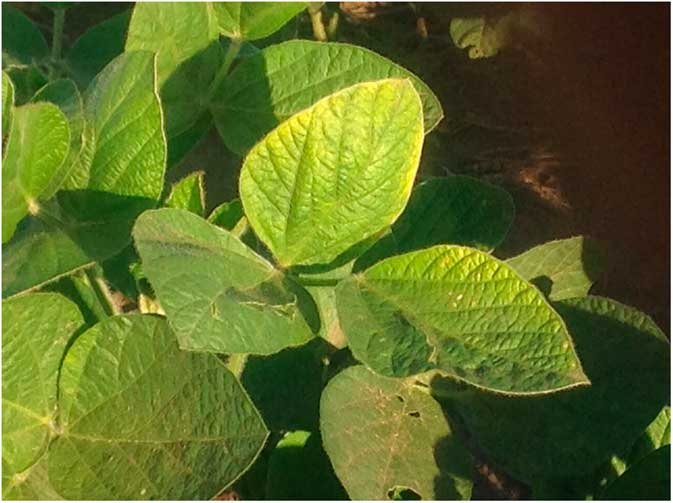
Figure 2 Chlorosis in Enlist E3 soybean leaves 7 days after application of glufosinate at 600 g ha−1 plus ammonium sulfate at 2% (v/v).
Table 4 Visual injury and yield of Enlist E3™ soybean in a temperate region (Humid Pampa) of Argentina from 2013 through 2016 cropping seasons.Footnote a
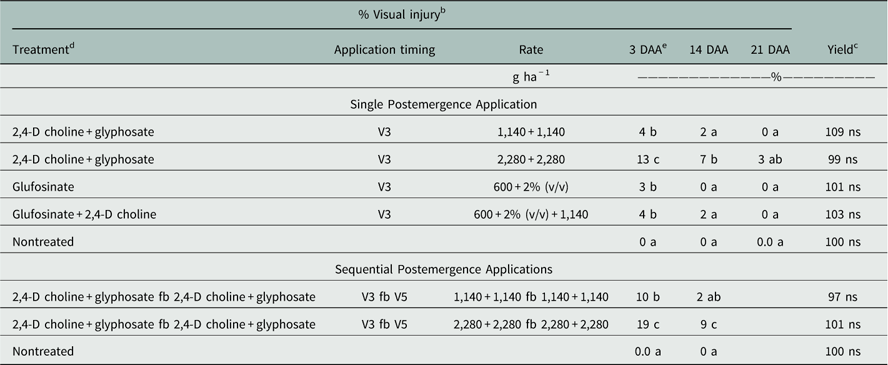
a Injury and yield data for the 2,4-D choline plus glyphosate treatments averaged over 14 locations. Injury and yield data for glufosinate were averaged over 11 locations. Means within a column with no common letter(s) are significantly different according to Tukey’s HSD at P≤0.05.
b Injury ratings taken after the final application within the treatment.
c Yield was converted to % of the paired untreated plot located immediately behind and adjacent to each treated plot before analysis.
d All 2,4-D choline plus glyphosate treatments contained MSO at 0.5% (v/v). All glufosinate treatments contained ammonium sulfate at 2% (v/v).
e Abbreviations: DAA, days after last application within the treatment; fb, followed by.
Table 5 Visual injury and yield of Enlist E3 soybean in a subtropical region of northwestern Argentina across trials conducted in cropping seasons from 2013 through 2016.Footnote a

a Injury and yield data for the 2,4-D choline plus glyphosate treatments averaged over 14 locations. Injury and yield data for glufosinate were averaged over 11 locations. Means within a column with no common letter(s) are significantly different according to Tukey’s HSD at P≤0.05.
b Injury ratings taken after the final application within the treatment.
c Yield was converted to % of the paired untreated plot located immediately behind and adjacent to each treated plot before analysis.
d All 2,4-D choline plus glyphosate treatments contained MSO at 0.5% (v/v). All glufosinate treatments contained ammonium sulfate at 2% (v/v).
e Abbreviations: DAA, days after last application within the treatment; fb, followed by.
The greatest injury was observed with sequential POST applications of 2,4-D choline plus glyphosate DMA and occurred at 3 days after the V5 application. The sequential applications resulted in 10% and 19% soybean injury at 1× and 2× rates, respectively, in Humid Pampa (Table 4) and 11% and 27 % injury by 1× and 2× rates, respectively, in northwestern Argentina (Table 5). Necrotic spots were more evident on plants treated with the 2× rate, but excellent crop recovery was observed at all locations for all soybean varieties. Robinson et al. (Reference Robinson, Simpson and Johnson2015) reported small necrotic spots on leaves intercepting the spray droplets of 2,4-D at 2,240 g ha−1, but observed that new leaves emerging after application were not affected.
Enlist E3™ soybean yield was not adversely affected by any herbicide treatment (Tables 4 and 5). This is in agreement with previous research in which soybean yield was not affected by applications of 2,4-D at 1,120 or 2,240 g ha−1 (Robinson et al. Reference Robinson, Simpson and Johnson2015).
Enlist E3™ soybean was tolerant to 2,4-D choline in mixture with glyphosate DMA when applied at the maximum label use rate of 1,140 g ha−1 POST at the V3 and V3 followed by V5 soybean stages. In all trials, leaf necrosis was the primary injury symptom observed following POST applications of 2,4-D choline plus glyphosate. Applications of 2,4-D choline in single or sequential applications at 1× or 2× rates did not adversely affect soybean yield when compared to the weed-free plots that did not receive herbicide treatment and where weeds were removed by hand periodically during the season. Yields of the seven varieties of Enlist E3™ soybean that ranged from maturity groups 3.7 to 6.2 were not adversely affected when treated POST with single or sequential applications of 2,4-D choline plus glyphosate DMA at 1× or 2× rates or 2,4-D choline plus glufosinate at 600+1,140 g ha−1.
Efficacy
Sequential PRE followed by POST applications of glyphosate at V4 and again at V6 provided 16% control of GR Sumatran fleabane at 14 days after the V6 application (Table 3). Burndown application based on triple mixtures of glyphosate plus dicloransulam plus halauxifen or diclosulam followed by glyphosate plus 2,4-D choline POST provided greater than 90% control of GR Sumatran fleabane at 42 days after the preplant and 14 days after the LPOST application (Table 3, Figure 3). Application of glyphosate plus 2,4-D choline plus diclosulam applied PRE followed by glufosinate 10 days later provided 97% control of Sumatran fleabane prior to POST applications. All POST-applied treatments that included 2,4-D choline achieved greater control than did the treatments with only glyphosate sprayed POST (Table 3).
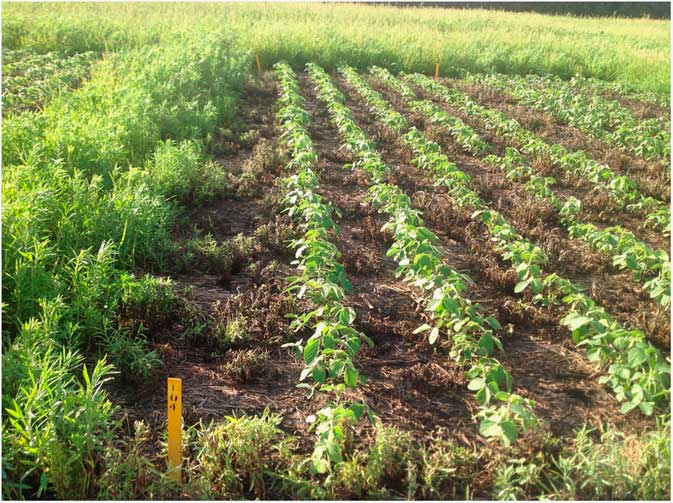
Figure 3 Herbicide program in Enlist E3™ soybean for control of glyphosate-resistant Sumatran fleabane in Argentina. The study is based on a preplant foundation treatment of glyphosate DMA at 1,200 g ha−1 plus diclosulam at 25.2 g ha−1 plus halauxifen at 5 g ha−1 followed by glyphosate DMA at 1,200 g ha−1 plus 2,4-D choline at 900 g ha−1 in postemergence at V3 with untreated on left.
Programs that included PRE-applied 2,4-D choline or halauxifen plus 2,4-D choline applied POST resulted in higher soybean yield than did treatments that did not include POST-applied 2,4-D choline (Table 6). Halauxifen-methyl applied PRE or glufosinate applied at planting resulted in about a 25% increase in yield. A 55% yield reduction resulted from weed control programs that included sequential glyphosate applications alone (Table 6).
Table 6 Percent yield increase over the current commercial standard of glyphosate plus 2,4-D choline plus chlorimuron followed by glyphosate.
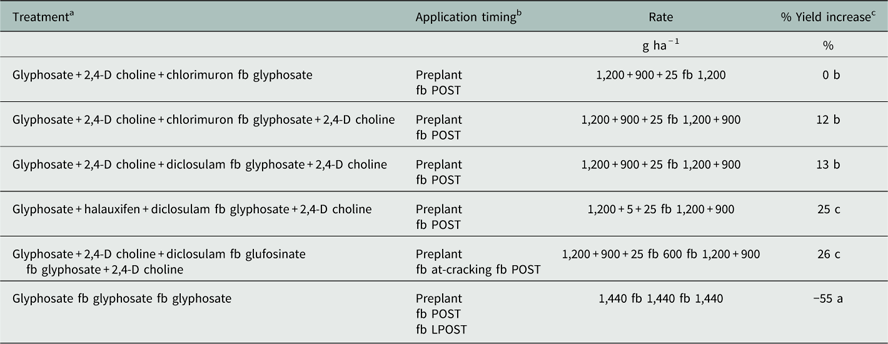
a Glufosinate treatments included ammonium sulfate at 2% (v/v).
b Abbreviations: Preplant, 3 to 5 days before planting; at-cracking, 10 days after preplant; POST, 42 days after planting; LPOST, 14 days after POST application; fb, followed by.
c Yield converted to % increase or decrease versus the current commercial standard treatment of glyphosate plus 2,4-D choline+chlorimuron fb glyphosate. Means within a column with no common letter(s) are significantly different according to Tukey’s HSD at P≤0.05.
Sumatran fleabane continues to be highly problematic in soybean cropping systems in Argentina. Control programs using glyphosate alone over the top to control Sumatran fleabane is a common practice, but provides poor control of GR biotypes in Argentina. Enlist E3 soybean with resistance to glufosinate, glyphosate, and 2,4-D choline provided a good option as a part of an effective program for herbicide resistance management by bringing three modes of action. Moreover, preplant applications of diclosulam plus halauxifen bring yet another mode of action for robust weed management programs to control Sumatran fleabane.
Acknowledgement
TM Enlist, Enlist E3, Colex-D, and Panzer Gold are trademarks of the Dow Chemical Company (“Dow”) or an affiliated company of Dow. Enlist E3 soybean was jointly developed by M.S. Technologies and Dow AgroSciences Collaboration.


